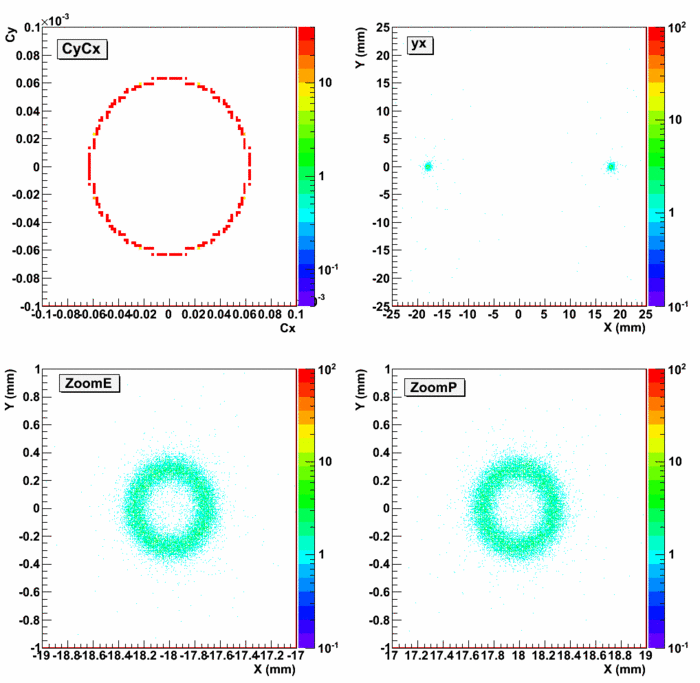Difference between revisions of "Polarimeter 11 01 2010"
From GlueXWiki
(→Some results) |
|||
| Line 64: | Line 64: | ||
:# Silicon detector <math>3 \times 10^{-3} X_{0}</math> | :# Silicon detector <math>3 \times 10^{-3} X_{0}</math> | ||
:# Coherent-range γ-flux 10<sup>7</sup> Hz, total flux through the target 10<sup>8</sup> Hz | :# Coherent-range γ-flux 10<sup>7</sup> Hz, total flux through the target 10<sup>8</sup> Hz | ||
| − | ::*Total background rate is: <math> R_{bkg} = \left( 10^{8} Hz | + | ::*Total background rate is: <math> R_{bkg} = \left( 10^{8} Hz \cdot \frac{3}{\sim 3} \right)^{2} 20 \cdot 10^{-9}~ns = 200~Hz </math> |
| − | ::*Total pair production rate is: <math> R_{sig} = 10^{7} Hz | + | ::*Total pair production rate is: <math> R_{sig} = 10^{7} Hz \cdot 3 \cdot 10^{-5} = 300~Hz </math> |
::* We have ~50% background if we leave the detector in the beam line. | ::* We have ~50% background if we leave the detector in the beam line. | ||
| − | ::* We can reduce it to 5% background at running at signal rate of 20Hz (assumes 100% acceptance). | + | ::* We can reduce it to 5% background at running at signal counting rate of 20Hz (such a rate assumes 100% acceptance). |
* Turning magnet on will get rid of the problem, but the magnetic field effects need to be dealt with. More work is needed for that but judging from the Reference 2 above this might be doable without a slit. (slit in this case would have to be less than 1mm wide which will interfere with the beam and not allow to sample the whole beam. | * Turning magnet on will get rid of the problem, but the magnetic field effects need to be dealt with. More work is needed for that but judging from the Reference 2 above this might be doable without a slit. (slit in this case would have to be less than 1mm wide which will interfere with the beam and not allow to sample the whole beam. | ||
Revision as of 10:16, 1 November 2010
Contents
Preliminary evaluation of the options for polarimetry with nuclear pair production
References
- A photon beam polarimeter based on nuclear e+e- pair production in an amorphous target
- Experimental study of photon beam polarimeter based on nuclear e+e- pair production in an amorphous target
Considered Options
- Put a an e+e- detector in the beamline before the PS magnet allowing for ~2.5 m lever arm.
- Pros
- No magnetic field distortions.
- Cons
- Short lever arm.
- Detector is exposed to the photon beam.
- Pros
- Put a an e+e- detector in the beamline after the PS magnet allowing for ~4.5 m lever arm, no B-field.
- Pros
- Relatively longer lever arm.
- Cons
- Detector is exposed to the photon beam.
- Small distortion effects due to incomplete degaussing of the PS magnet.
- Pros
- Put separate e+ and e- detectors off the beamline after the PS magnet allowing for ~4.5 m lever arm, small
 T m.
T m.
- Pros
- Relatively longer lever arm.
- Detector not exposed to the beam
- Cons
- Magnetic field mixes different momenta and angles at the same position of the detector.
- Distortion due to the fringe fields.
- Pros
Simulations
- Use GEANT4 based program to simulate the basic features. The geometry may have conflicts with the current Hall D beamline configuration.
- Symmetric Pairs are simulated with
 GeV, and θ=6 x 10-5 rad in the lab.
GeV, and θ=6 x 10-5 rad in the lab. - All pairs pass through a converter which is 6μm thick, positioned at z=0.
- 0.3 T constant dipole magnetic field in vertical direction starting at z=2.3 m with the magnetic length of 40 cm
- Vacuum window 100μm at z=4.45 m (5cm before the detector)
- Some sort of detector made of silicon, 300μm thick. Consists of two pieces, left and right, for positrons and electrons.
- The positions of the hit e+ or e- hits are calculated as the energy-weighed average of individually hits within certain window.
- Simulated 40K symmetric pairs with the fixed θ-angle and momentum in the lab, and uniformly distributed in φ.
Some results
- One can see the circles corresponding to the constant momentum and angle. The separation is one the order of 0.4 mm after the magnet.
If we do not use and B-field and leave the detector in the beamline this still will be the separations, B-field does not affect these circles.
- The background will become an issue. If we increase the converted thickness to 50μm the circle will collapse into a blob. We can try to very roughly estimate the background contributions assuming:
- Converter

- Silicon detector

- Coherent-range γ-flux 107 Hz, total flux through the target 108 Hz
- Total background rate is:

- Total pair production rate is:

- We have ~50% background if we leave the detector in the beam line.
- We can reduce it to 5% background at running at signal counting rate of 20Hz (such a rate assumes 100% acceptance).
- Total background rate is:
- Converter
- Turning magnet on will get rid of the problem, but the magnetic field effects need to be dealt with. More work is needed for that but judging from the Reference 2 above this might be doable without a slit. (slit in this case would have to be less than 1mm wide which will interfere with the beam and not allow to sample the whole beam.

